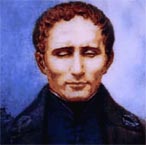Braille's alphabet touches lives 200 years after his birth
 Paris - Nearly 200 years after the birth of Louis Braille, the alphabet of raised dots he created to overcome his lack of sight continues to touch the lives of blind people everywhere.
Paris - Nearly 200 years after the birth of Louis Braille, the alphabet of raised dots he created to overcome his lack of sight continues to touch the lives of blind people everywhere.
Braille was born on January 4, 1809, near Paris. The son of a saddler, he injured his eye with an awl when he was three years old. The resulting infection spread to both eyes and he was soon blind.
Despite his blindness, he continued to attend a regular village school until the age of 10, when he enrolled at the Royal Institution for Blind Youth in Paris.
There, while his fellow students slept, he began punching dots into soft wood to create an alphabet.
Inspired by a secret military alphabet that could be used to convey messages in the dark, Braille created a six-point system of dots with 63 possible combinations, now widely recognized as the Braille alphabet.
When completed, the alphabet could represent all the letters of the Latin alphabet, along with the digits 0 through 9, plus mathematical symbols and punctuation.
Devised in 1829, the alphabet is still in regular use by 150 million blind people worldwide.
It continues to be a common feature in education and work settings, despite the development of advanced computers to help blind people read.
Indeed, no language for the blind before or since has ever become so well established.
That's because Braille is not only so easy to learn, it also functions simultaneously for reading and writing.
"You can do a lot with computers and audio technology. But with purely audio media, you can only reach people who can no longer read and write themselves," says Peter Brass, president of the Community of Vision-Impaired Computer Users.
Since people need to be able to read notices, signs and notes in day-to-day life, the Braille alphabet remains indispensable to many.
Braille completed the alphabet when he was 16 and eventually became a teacher at the school, where he taught his alphabet until his death in 1852 of tuberculosis.
Although he was well-known during his lifetime, his alphabet did not achieve worldwide acclaim until several years after his death.
Because of this contribution to society, Braille is venerated around the world.
In 1952 in his native France, his ashes were reinterred in the Pantheon in Paris, the final resting place for that country's great men and women. (dpa)